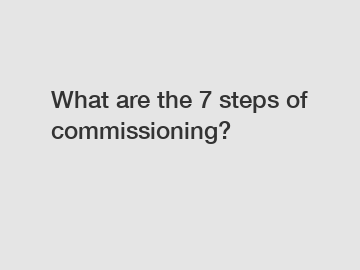What are the 7 steps of commissioning?
Goto TimEast to know more.
As a leader in the industry, I have been involved in numerous commissioning projects and have seen the importance of following a structured process to ensure successful outcomes. Commissioning is a crucial step in any construction project as it involves testing and verifying that all systems are working correctly before the building is handed over to the client. In this blog, I will outline the seven steps of commissioning that are essential for a successful project.
The first step in the commissioning process is to establish a commissioning plan. This plan outlines the scope of work, responsibilities of each team member, and the timeline for completion. It is crucial to have a detailed plan in place to ensure that all aspects of the commissioning process are covered and that everyone involved is clear on their roles and responsibilities.

The second step is to conduct a design review. During this phase, the commissioning team will review the building plans and specifications to identify any potential issues or discrepancies that could impact the performance of the systems. It is essential to address these issues early on to avoid costly delays or rework later in the project.
Once the design review is complete, the next step is to develop a commissioning schedule. This schedule outlines the tasks that need to be completed, the order in which they should be done, and the timeline for completion. A well-thought-out schedule is critical for keeping the project on track and ensuring that all systems are functioning correctly before the building is turned over to the client.
The fourth step in the commissioning process is to conduct pre-functional testing. This involves testing each system individually to ensure that it is installed correctly and functioning as it should. It is crucial to identify any issues during this phase so that they can be addressed before the building is handed over to the client.
The fifth step is to conduct functional testing. During this phase, the commissioning team will test the systems as a whole to ensure that they are working correctly and interacting with each other as intended. Functional testing is a critical step in the commissioning process as it ensures that all systems are integrated and functioning properly before the building is occupied.
The sixth step is to develop a commissioning report. This report outlines the results of the commissioning process, including any issues that were identified and how they were addressed. It is essential to have a detailed report to document the commissioning process and ensure that all systems are working correctly before the building is handed over to the client.
The final step in the commissioning process is to conduct a training session for the building operators. This training session provides the building staff with the information they need to operate and maintain the systems effectively. It is crucial to ensure that the building operators are properly trained to prevent issues from arising once the building is occupied.
In conclusion, following the seven steps of commissioning is essential for a successful construction project. By establishing a commissioning plan, conducting design and functional testing, and developing a detailed report, you can ensure that all systems are working correctly before the building is handed over to the client. Commissioning is a critical step in the construction process, and by following these steps, you can ensure that your project is completed on time and within budget.
Please visit our website for more information on this topic.
For more Retro Jettinginformation, please contact us. We will provide professional answers.



